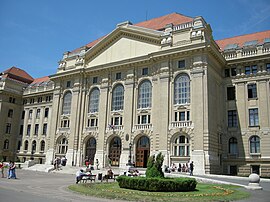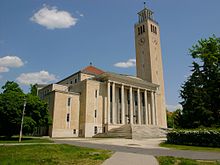University of Debrecen
| University of Debrecen | |
|---|---|

|
|
| founding | 1538 and 1912 |
| Sponsorship | state |
| place | Debrecen , Hungary |
| Rector | Zoltán Szilvássy |
| Students | about 30,500 (2011) |
| Employee | about 1,425 scientific staff |
| including professors | 212 |
| Website | www.unideb.hu |

The University of Debrecen (Hungarian Debreceni Egyetem ) is one of the most famous universities in Hungary . It emerged from the amalgamation of formerly four universities that were merged on January 1, 2000 to form the University of Debrecen:
- Lajos Kossuth University
- Medical University of Debrecen
- Agricultural University of Debrecen
- Pedagogical College “István Wargha” in Hajdúböszörmény
structure
The university is divided into the following faculties:
- Faculty of Agriculture (Agrárgazdasági és Vidékfejlesztési Kar)
- Faculty of Political Science and Law (Állam- és Jogtudományi Kar)
- Faculty of General Medical Sciences (Általános Orvostudományi Kar)
- Faculty of Humanities (Bölcsészettudományi Kar)
- Faculty of Musicology, Debrecen Conservatory (Debreceni Egyetem Konzervatóriuma)
- Faculty of Health Care (Egészségügyi Főiskolai Kar)
- Faculty of Dentistry (Fogorvostudományi Kar)
- Faculty of Pharmacy (Gyógyszerésztudományi Kar)
- Hajdúböszörmény Faculty of Education (Hajdúböszörményi Pedagógiai Főiskolai Kar)
- Faculty of Computer Science (Informatikai Kar)
- Faculty of Economics (Közgazdaságtudományi Kar)
- Faculty of Natural Resources and Life Sciences (Mezőgazdaságtudományi Kar)
- Technical Faculty (Műszaki Kar)
- Faculty of Science (Természettudományi Kar)
Library
The University of Debrecen houses the second largest national library in Hungary with collections on the humanities and social sciences, natural sciences, agricultural sciences, technology, education, economics, law and musicology. Your archive houses more than 6 million volumes.
Summer university
In 1927, the university started its language courses, which are still famous today across the borders of Hungary, in its specially founded summer university. At that time it was the only institution of its kind that made it possible for foreigners and foreign speakers to learn the Hungarian language . In addition to the language, Hungarian history and cultural studies are also taught under the heading of Hungarology . The Summer University ( Debreceni Nyári Egyetem ) is an independent institution that operates as a non-profit limited company. In 2002 a language school was opened as a branch in the Hungarian capital Budapest ( Debreceni Nyári Egyetem Budapesti Nyelviskolája ).
history
Beginnings
The university's roots go back to the 16th century, when the Calvinist College (ung. Debreceni Református Kollégium ) was founded in Debrecen in 1538 . As early as 1567 the college began training pastors and teachers. For centuries, the college was an important center for research and teaching of the Hungarian language and culture.
From 1588 onwards, all graduates of the college are already known by name. The students had a representation with strong rights, Coetus , which was integrated into the city council alongside the rector. Well-known textbook publications by the university, such as a legal handbook, 1577 Arithmeticaja by János Laskói, Dicta Graecia sapientum as well as interprete Erasmo Rotterdamo and Civilitas morum Erasmi date from this period .
- 1800: Start of teaching in law
- 1853–54: Four own juridical chairs
- 1856: Pedagogical seminar
Royal University
On July 7, 1912, King Franz Joseph founded the Royal University of Debrecen, into which three faculties from the Calvinist College of the newly founded university were incorporated. The following five faculties were planned:
- Reformed theology
- Law and Political Science
- Medical sciences
- Humanities, language and history
- Natural sciences
In October 1914, the university began operations in the buildings of the Calvinist college. From 1921 the university named itself after one of its former students and Prime Minister of Hungary, István Tisza , in whose honor a statue was erected in front of the main hospital building in 1923.
Construction of the new university building
As early as 1913, plans were made to move the university to its own campus - the “University City ” (Egyetemváros) . The university and its clinics were relocated to the area in the north of the city, which is still used today, on the edge of the large forest (Nagyerdő) . The campus was divided into the following systems and facilities:
- Medical Faculty Complex
- Main building with library
- Science buildings
- Botanical garden and glass houses
- Apartment villas for professors and teachers
- Youth sports fields (in Hungary, sports are a compulsory subject for every degree)
Construction of the university, which began in 1914, was completed by King Charles IV on October 23, 1918 . solemnly inaugurated. However, the completion of the building was delayed due to the war - so the clinic could not begin full operation until 1921, whereby the entire area was not completed until 1927. The main building, which dominates the campus today, was built between 1927 and 1932 by the architect Flóris Korb. The observatory was built in 1930 and the botanical garden in 1933. 1939–1942, the university church was built next to the main building according to plans by József Borsos.
The time of division 1945–1989
When the socialist regime came to power, all traces of István Tisza at the university were removed - his statue was torn down. In 1949 the humanities and natural sciences faculties were split up and the law faculty dissolved, and in 1950 the theological faculty and 1951 the medical faculty were spun off into separate universities. The humanities faculty was made even smaller: teaching in English, French, German and Latin was discontinued at short notice until 1958. The theological faculty is still an independent university subordinate to the Calvinist diocese . The remaining university, consisting of the humanities and natural sciences faculties, was named Lajos Kossuth University in 1952 . With the division of the university, the range of courses was later expanded: in 1953 the Academy of Natural Resources and Life Sciences Debrecen was established - later the University of Natural Resources and Life Sciences. In 1966 the music college was established and in 1972 the technical college. In 1971 the Hajdúböszörmény kindergarten school started teaching.
Reunification 1989–1999
In the mid-1980s, the party sought to reunite the scattered institutes and colleges into one university. On June 22, 1991, President Árpád Göncz announced the reunification of the universities to form the Debrecen University Association (Debreceni Universitas Egyesülést (DUE)) consisting of the University of Agricultural Sciences (Debreceni Agrartudományi Egyetem (DATE)) , the Medical University (Debreceni Orvostudományi Egyetem) (DOTEgy)) , the Lajos Kossuth University (Kossuth Lajos Tudományegyetem KLTE) , the Reformed Theological College (Debreceni Református Teológiai Akadémia (DRTA, DRHE)) and the Atomic Nuclear Research Institute (MTA Atommagkutató Intézet (ATOMKI)) . The union of universities was not yet legally to be regarded as a university, but plans were made to create a university out of the union. In 1996, with the support of the World Bank, the further integration of the individual independent universities into a joint university in Debrecen began. In 1998 the Franz Liszt College of Music was included in these plans.
The new University of Debrecen 2000
On January 1, 2000, the combined faculties or universities in Debrecen began operations under the name of "University of Debrecen" (Debreceni Egyetem, 'DE) . The merged institutes or faculties were now also legally one university. When it was merged in 2000, the university had five university faculties, three university faculties and two independent institutes:
- General Faculty of Medicine
- Faculty of Humanities
- Faculty of Business and Economics
- Faculty of Agricultural Sciences and Natural Resources and Life Sciences
- Faculty of Science
- Faculty of Health Care
- Technical Faculty
- Hajdúböszörmény Faculty of Education
- Faculty of Law and Political Science
- Debrecen Conservatory
A continuous development has been observed after the unification. The Faculty of Agriculture and Natural Resources and Life Sciences was founded in 2002, the Faculty of Dentistry and the Faculty of Pharmacy in 2003. In 2004, the Institute for Computer Science separated from the Institute for Mathematics in the Faculty of Natural Sciences and formed the independent Faculty for Computer Science.
The University of Debrecen today
Today the university has 10 university faculties and 3 university faculties as well as 2 independent institutes. The establishment of a Faculty of Public Health is currently under way.
Famous Graduates
- Endre Ady (1877-1919), poet
- János Arany (1817–1882), poet
- Ézsaiás Budai (1766–1841), historian and philologist
- Mihály Csokonai Vitéz (1773–1805), poet
- Bálint Csűry , linguist
- Pál Ember Debreczeni , theologian
- Dezső Baltazár (1871–1936), theologian and lawyer
- Sámuel Diószegi (1760–1813), botanist and theologian
- Lajos Domokos (1728–1803), writer and politician
- Mihály Fazekas (1766–1828), poet and botanist
- István Hatvani (1718–1785), mathematician and scientist
- Endre Hőgyes (1847–1906), medic
- Sándor Imre , literary and linguist
- Ferenc Kerekes (1799–1850), chemist and mathematician
- Ferenc Kölcsey (1790–1838), politician, reformer and poet
- Sándor Kövy , lawyer and theologian
- József Lugossy (1812–1884), orientalist and linguist
- György Maróthi (1715–1744), music theorist and mathematician
- Ferenc Medgyessy (1881–1958), sculptor (stonemason)
- Zsigmond Móricz (1879–1942), writer
- József Pápay , linguist
- Imre Révész , theologian
- István Weszprémi (1723–1799), doctor and medical historian
Partner universities
The University of Debrecen has partner universities all over the world:
- University of Kentucky , Lexington, Kentucky, USA
- Indiana University , Bloomington, Indiana, USA
- University of Missouri , St. Louis, USA
- San Diego State University , USA
- University of Georgia , USA
- California Polytechnic State University , San Luis Obispo, USA
- Johannes Kepler University Linz , Austria
- Konstantin Preslavsky University of Shumen , Bulgaria
- University of Reading , UK
- Jyväskylä Polytechnic University , Finland
- Jyväskylä University , Finland
- University of Clermont-Ferrand II Blaise Pascal , France
- Leiden University , Netherlands
- Ahmad Dahlan University Yogyakarta , Indonesia
- University of Haifa , Israel
- Tohoku University , Sendai , Honshu, Japan
- University of Chiba , Honshu, Japan
- Hirosaki University , Japan
- University of Rostock , Germany
- University of Paderborn , Germany
- Humboldt University of Berlin , Germany
- Universitatea de Vest Vasile Goldiș , Romania
- Oradea University , Romania
- Christian University of the Partium Oradea , Romania
- University of the West Timișoara , Romania
- Babeș-Bolyai University of Cluj , Cluj-Napoca, Romania
- Pavol Jozef Šafárik University Košice , Slovakia
- Uzhhorod State University , Ukraine
See also
literature
- Josef Gál: The HC University in Debreczin. In: Allgemeine Bauzeitung , year 1876, pp. 43–47 (online at ANNO ).
Web links
- University of Debrecen
- Medical Science Center Debrecen
- University and National Library Debrecen (with catalog search option)
- The HC University in Debrezin. In: Allgemeine Bauzeitung, 1876 ( with plans ) on Anno (Austrian Newspapers Online)
Individual evidence
- ^ Study in Hungary: University of Debrecen
- ↑ University of Debrecen: Facts and figures (2011) Retrieved on February 26, 2012.
- ↑ Debreceni Nyári Egyetem - 1927. Accessed August 8, 2020 (Hungarian, English, German).





